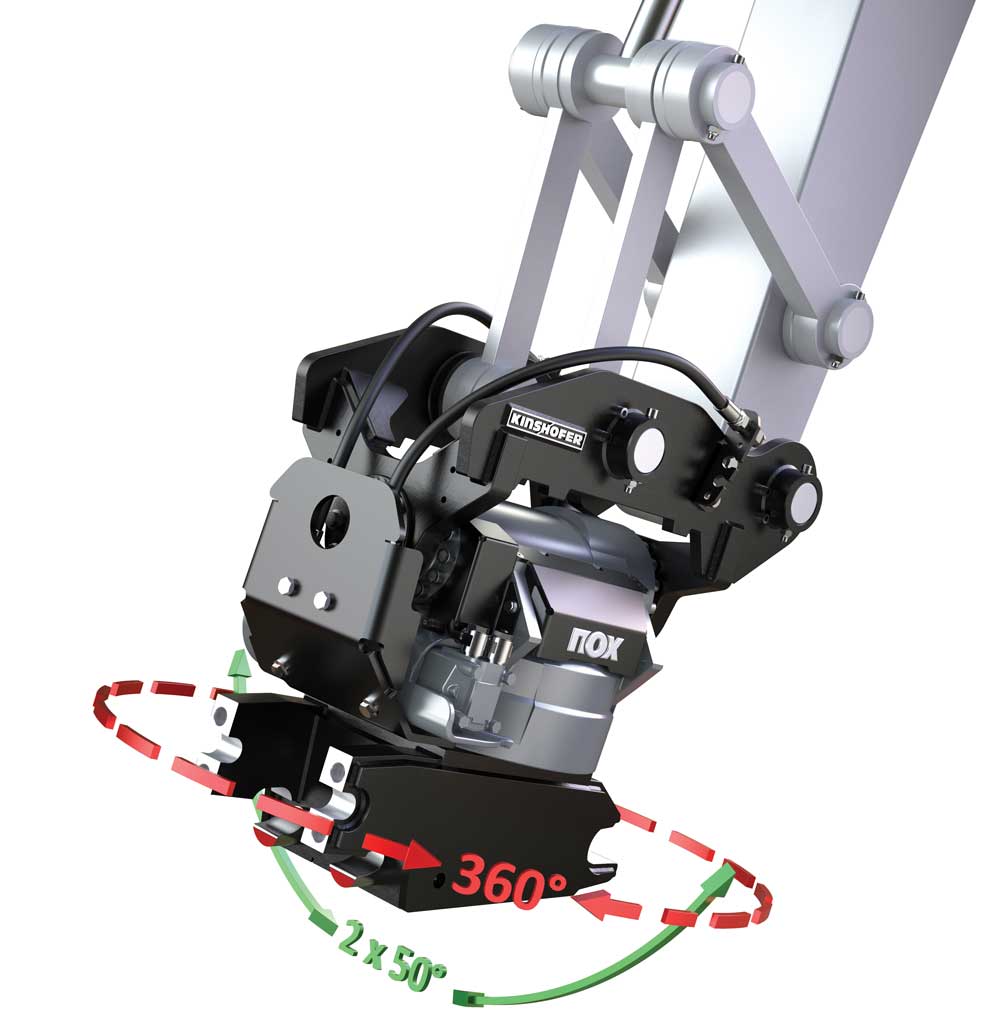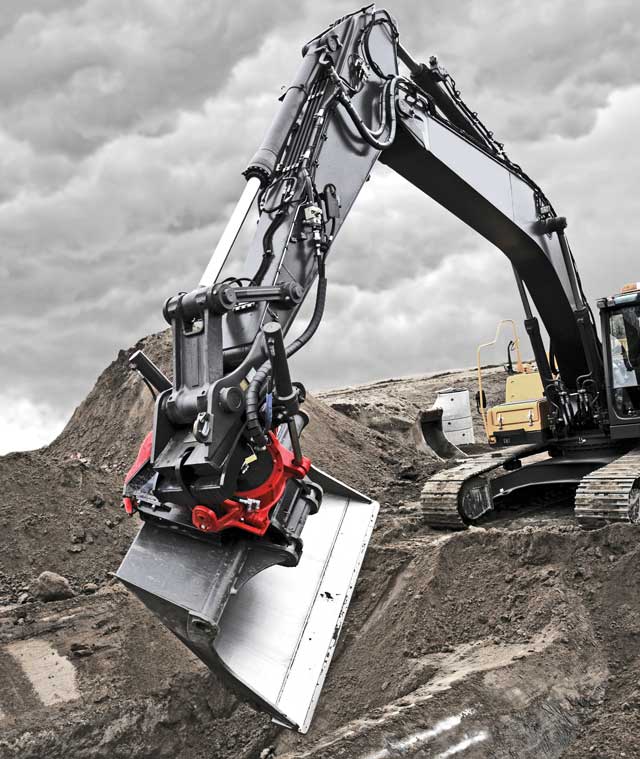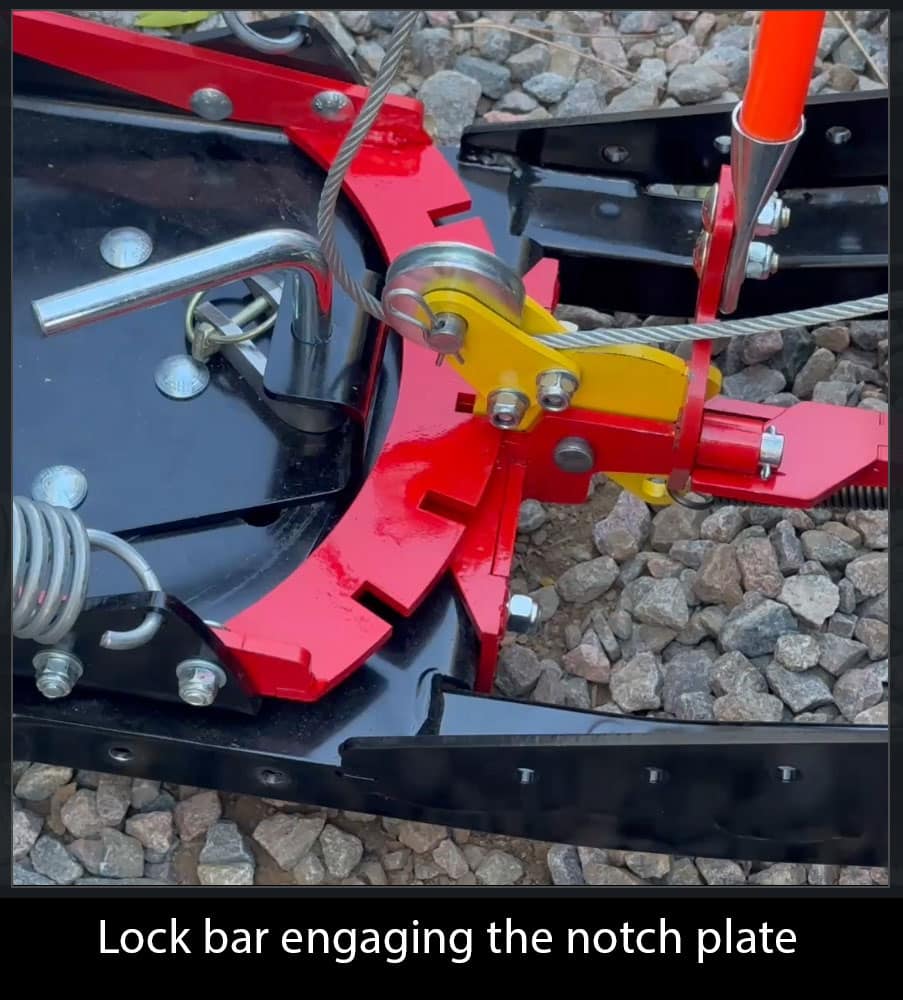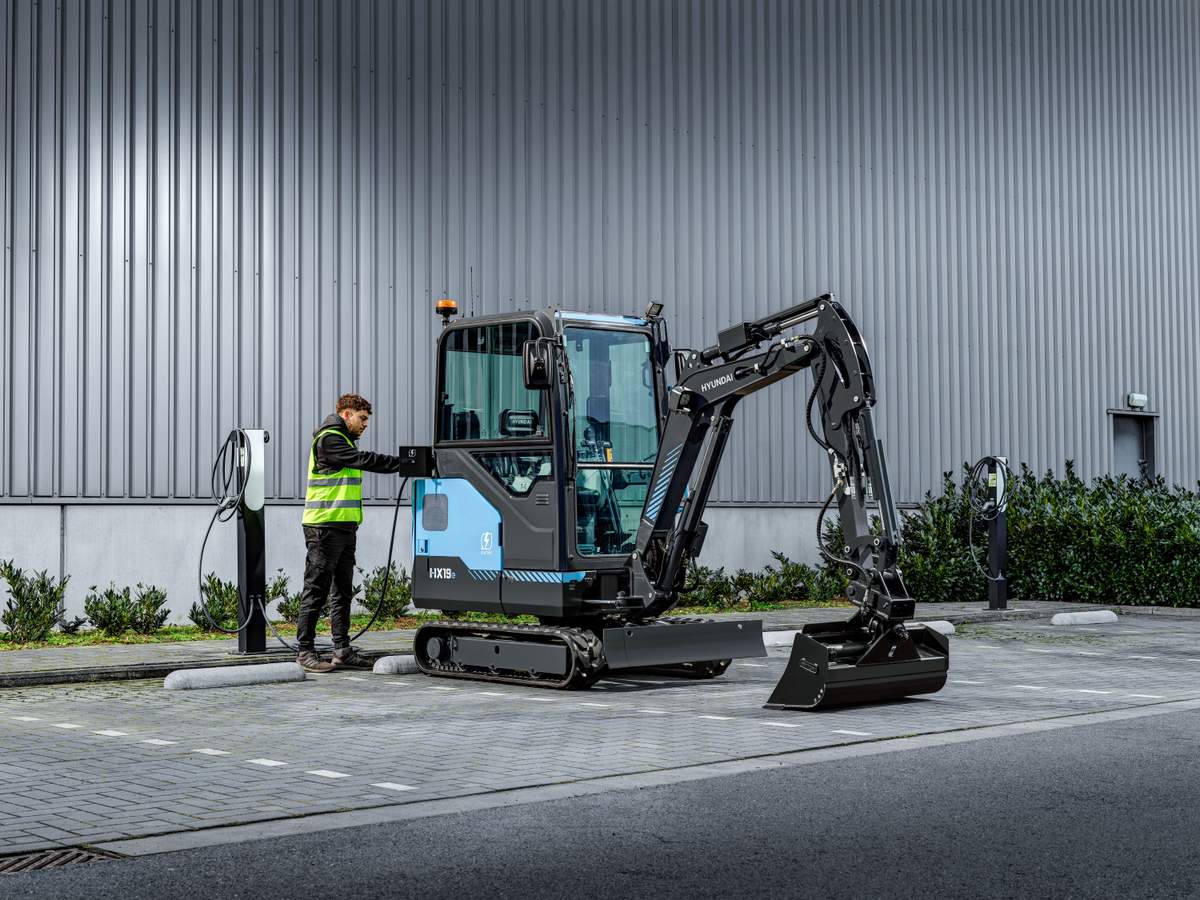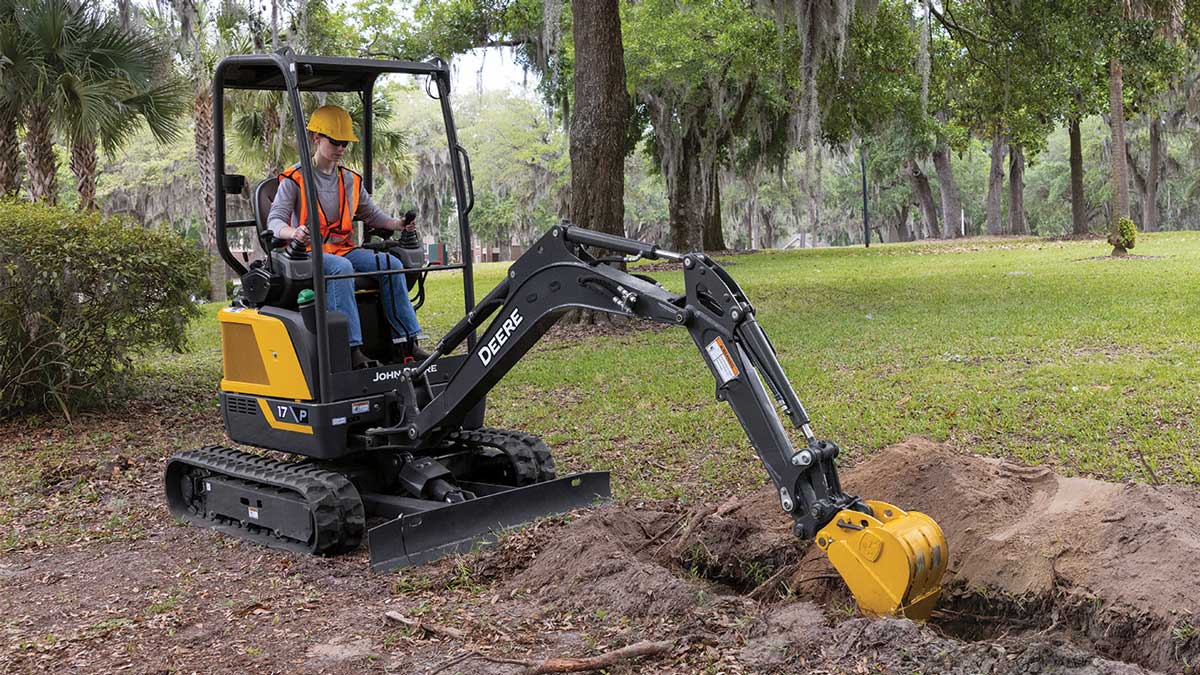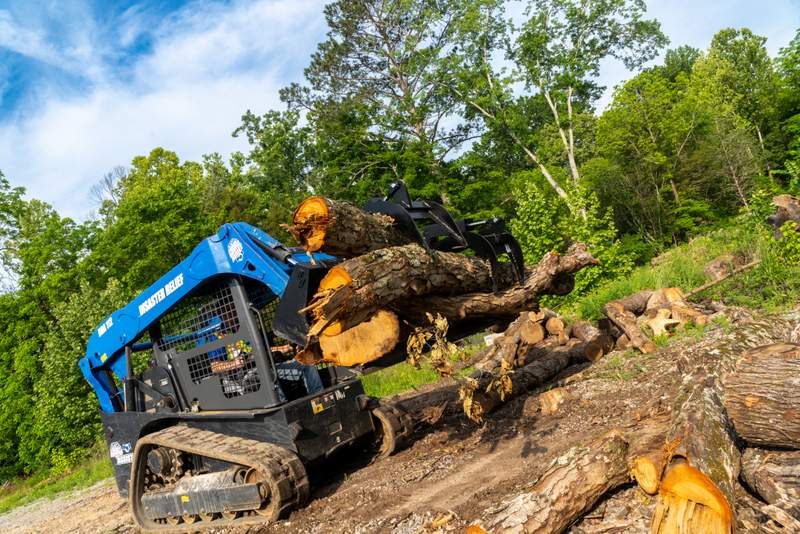Excavator Dexterity: Tilt and Tiltrotator Couplers Enhance Flexibility, Accuracy and Efficiency
Using an excavator bucket to create the vertical sidewalls of a trench is one thing. Rotating that bucket 360 degrees while scooping up soil, carving out precision slopes and thumbing odd-shaped rocks into hard-to-reach spots — well, that’s something else altogether. The ability to do that “something else” on an excavator comes courtesy of a tilt-and-rotate coupler typically called a tiltrotator or a tilt coupler (the latter only rotating 180 degrees).
These rotating attachment plates give excavator operators flexibility and accuracy, saving fuel in the process and shrinking the time required for common excavator apps. The flexible wrist coupling technology makes buckets, forks, grapples and other attachments more versatile. The technology is not new. It was developed 40 years ago in Scandinavia, but it continues to be refined today and is slowly carving out market share in the United States.
“Tiltrotator couplings are time-savers on all types of jobs, except bulk moving where you only need to dig a big hole without precision,” says Sten Stromgren, communications manager for engcon Group. “For example, ditching — you can dig along beside the excavator and don’t need to set up in the street. When you dig for cables or pipes in narrow areas, you don’t need to move the machine around the whole time. When you’re backfilling, you can stand in one spot and swivel the bucket to the exact position needed.”
The engcon Group brought its tiltrotator product to the U.S. market a decade ago from Sweden. In 2017, it set up a North American office, an indication of the growing market on this side of the Atlantic. The hottest-selling couplers are for midsize excavators — 6- to 20-metric ton machines. “But we also sell a lot of tiltrotators for 1.5- to 6-ton excavators as well as for bigger machines,” Stromgren says. The smallest tiltrotator coupler weighs just 140 lbs. Quick-coupling systems are standard for each model.
Kinshofer introduced its cylinderless NOX-Tiltrotator to North America in 2012. The mechanism employs a patented elliptic rotary actuator that is said to deliver more constant torque across a full 50 degrees of tilt in each direction, thus giving the tool more productive power in extended situations. In addition, the NOX produces a narrower coupler than some competing brands due to its lack of rams. This more compact, cylinderless package benefits any operator working in tight conditions. The Kinshofer coupler is relatively low maintenance as well, with hydraulic features integrated into a solid casting rather than being exposed to elements and operational conditions. It has two grease points, considerably fewer than some rival products and the rotational component is a worm drive immersed in oil, a durable piece of engineering.
The smallest NOX-Tiltrotator is designed for 3- to 6-ton compact excavators and weighs 264 lbs. Other models fit machines up to 25 tons. “The NOX is a highly durable tiltrotator with long life engineered into it thanks to its special casting,” says Francois Martin, general manager of Kinshofer North America. “Construction is changing, and the NOX cylinderless tiltrotators are helping to answer the needs of the next generation of excavator operators.”
An Irish manufacturer of excavator attachments, Geith International, eschews the rotational function. Its multi-position coupler is tilt-only. Geith does so for strategic marketing reasons. “Tiltrotator couplers get more showtime and publicity,” says Damien O’Connor, who oversees Geith’s sales and dealer support, “but market growth and demand for tilt couplers exceeds that of tiltrotators. It is a less expensive option with less maintenance of hydraulic and electrical components required.”
The smallest Geith coupler is a good fit for a 1- or 2-ton compact excavator, weighing only 114 lbs. Generation 3 Geith quick-couplers were introduced six years ago, and the tilt function is integrated into it. The tilt mechanism is most often employed in landscape work, according to O’Connor, but also accommodates digging of vertical trenches on sloped ground and similar utility applications. Of course, pivoting and/or swiveling couplers are not needed for every excavation job and — because they are a more highly engineered product than rigid couplers — they cost more. Manufacturers don’t emphasize the cost differential, but some do caution against abusing a multi-positional coupler.
“Usually a company will do its homework before investing in a tilt coupler,” O’Connor says. “This means the intended machine will have need of the tilt function for a high percentage of its applications.” If an excavator will be breaking rock or performing some other particularly stressful excavator task, O’Connor suggests it might be best “to remove the tilt coupler and fit a standard coupler in its place, which can take just 30 to 40 minutes tops.”
In 1986, another Swedish company, Rototilt Group, introduced the first mass-produced tiltrotator, bringing it to the U.S. market 12 years ago. In the last five years, the company has doubled its North American sales and is expanding its factory in Sweden. Models of the Rototilt tiltrotator can be married to mini excavators as small as 1.5 tons and to machines as heavy as 40 tons. Any task that requires reach and 360-degree angled maneuverability can utilize the attachment.
“With the tiltrotator, an operator becomes so much more versatile and can take on more types of jobs,” says Phil Lucoe, sales and marketing manager for Rototilt Inc. “Your imagination is the only limit.”
All of that agility on the end of an excavator boom naturally requires additional operator controls. Tilt-only couplers can be controlled with the common thumb-activated roller on a joystick. In addition, the excavator hosting it will need two-way auxiliary lines with three-position control valves and, ideally, proportional solenoids for smoother tilting and movement.
Tilt-rotator couplings are more nuanced and, consequently, the controls are more complex. Rototilt’s Innovative Control System (ICS) maximizes each coupler function. “Our control system will give an operator using the tiltrotator many extra and smart functions,” says Lucoe. The engcon Group tiltrotators are controlled by proprietary MIG2 joysticks.
Kinshofer’s coupler is operated with dual joysticks. “This increases sensitivity and limits operator fatigue,” says Martin. “In an optional fully proportional NOXPROP control system, tilt and rotation are controlled by proportional solenoid valves and can be run simultaneously.” A separate display screen gives NOX operators a fuller readout of what is happening. Some of this might seem daunting to a rookie excavator operator. However, each manufacturer rep interviewed encouraged first-time operators of an excavator with a tiltrotating coupler to be “open minded” about the new system — and expect to master it in pretty short order.
“The NOX is an intuitive tool, though learning varies depending on the operator,” says Martin. “Quick learning is normal once basics are mastered. Users should be open-minded in their approach to take full advantage of the new working methods available to them. Being creative helps to maximize the benefits from such a game-changing attachment.”
Lucoe at Rototilt says doing bucket work with a multi-positional coupler can be pleasurable. “The learning curve is quite quick since the operator soon sees the benefits of having a tiltrotator on the excavator. It can make the work more fun. Once operators try it, they don’t go back.”
Giles Lambertson is a freelance writer for Compact Equipment.
Safety-Focused Excavator Couplers
Nothing good comes from a bucket or fork falling off the working end of an excavator. The engcon Group’s solution to this hazard is called Q-Safe. Introduced a couple of years ago, Q-Safe firmly connects standard rigid buckets and other attachments to a boom. However, the Q-Safe coupler also can be firmly attached above or below a tilting and rotating coupler. The Q-Safe quick-coupler has a triple-protection system. It mechanically seats a tool as well as hydraulically locks it down. It also electrically monitors the locking mechanisms. In practice this means that until a Q-Safe unit firmly unites a bucket and tiltrotator coupler, a horn will keep sounding and a light will keep flashing. These visual and aural alarms don’t shut off until a hookup is electrically confirmed.
If that isn’t enough assurance for an operator — as well as for the people working nearby — the Q-Safe system will not release an attachment until it again rests on the ground. Why? Q-Safe requires ground pressure for de-coupling. The Rototilt Group also has a patented sensor-based safety system called SecureLock for both quick-couplers (machine couplers) and tiltrotators. The system has been around for over six years with thousands of units on the market. SecureLock gives the operator excellent support in making a correct decision if the quick-coupler and tiltrotator is locking up the tool or not. The SecureLock system can be part of the Innovative Control System. Knowing the attachment is going to stay attached might be the best tool of all.
Thumb’s Up
Solesbee’s series of manual and hydraulic excavator thumbs — available for any size and model excavator — allows operators to move from one application to another, such as moving dirt or material, without changing attachments. This versatility significantly increases efficiency for a variety of applications, including land clearing, site preparation, demolition and recycling. The thumb’s strength enables operators to easily grip materials of all sizes that a bucket cannot handle alone and generally require a significant amount of time for clearing. Contractors can quickly and easily grab and place materials, including trees, pipes, rocks and scrap materials, then fold the thumb down to use the bucket. The attachment can also remain on the carrier during other operations. A skilled welder can attach the thumb to the bucket and book arm, or bucket and coupler, in roughly two hours. The series is compatible with 32- to 78-in. tip radius buckets. For more info, visit solesbees.com.

